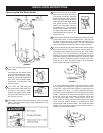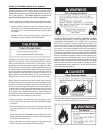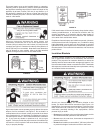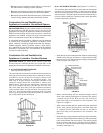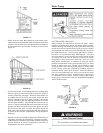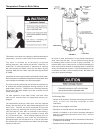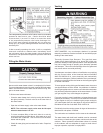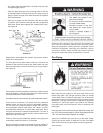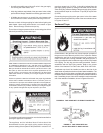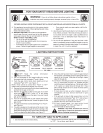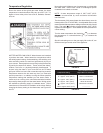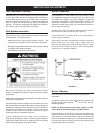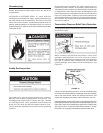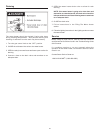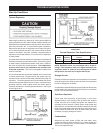
16
• Forproperdrafthoodattachment,thedrafthoodlegsmay
be angled slightly inward.
• Placethedrafthoodlegsinthereceivingholesonthetop
of the water heater. The legs will snap in the holes to give a
tightt.Securethelegsofthedrafthoodwiththesupplied
draft hood brackets.
• Placetheventpipeoverthedrafthood.Withtheventpipe
in position, drill a small hole through both the vent pipe and
draft hood. Secure them together with a sheet metal screw,
see Figure 18.
FIGURE 18.
Obstructed or deteriorated vent systems may present serious
health risk or asphyxiation.
The vent pipe from the water heater must be no less than the
diameter of the draft hood outlet on the water heater and must
slope upward at least 1/4 inch per linear foot (21 mm per meter),
see Figure 19.
FIGURE 19.
All vent gases must be completely vented to the outdoors of the
structure (dwelling). Install only the draft hood provided with the
new water heater and no other draft hood.
Vent pipes must be secured at each joint with sheet metal screws.
There must be a minimum of 6 inches (153 mm) clearance
between single wall vent pipe and any combustible material.
Fill and seal any clearance between single wall vent pipe
and combustible material with mortar mix, cement, or other
noncombustible substance. For other than single wall, follow
ventpipemanufacturer’sclearancespecications.Toinsurea
tighttoftheventpipeinabrickchimney,sealaroundthevent
pipe with mortar mix cement.
Failure to have required clearances between vent piping and
combustiblematerialwillresultinarehazard.
Be sure vent pipe is properly connected to prevent escape of
dangerousuegaseswhichcouldcausedeadlyasphyxiation.
Chemicalvaporcorrosionoftheueandventsystemmay
occur if air for combustion contains certain chemical vapors.
Spray can propellants, cleaning solvents, refrigerator and air
conditioner refrigerants, swimming pool chemicals, calcium
and sodium chloride, waxes, bleach and process chemicals
are typical compounds which are potentially corrosive.
GasPiping
Make sure the gas supplied is the same type listed on the
model rating plate. The inlet gas pressure must not exceed
14 inch water column (3.5kPa) for natural gas. The minimum inlet
gas pressure listed on the rating plate is for the purpose of input
adjustment. If the gas control valve is subjected to pressures
exceeding 1/2 pound per square inch (3.5kPa), the damage
tothegascontrolvalvecouldresultinareorexplosionfrom
leaking gas.
If the main gas line shut-off serving all gas appliances is used, also
turn“OFF”thegasateachappliance.Leaveallgasappliancesshut
“OFF”untilthewaterheaterinstallationiscomplete.
Agaslineofsufcientsizemustberuntothewaterheater.
Consult the current edition of National Fuel Gas Code ANSI
Z223.1/NFPA 54 and your gas supplier concerning pipe size.
There must be:



